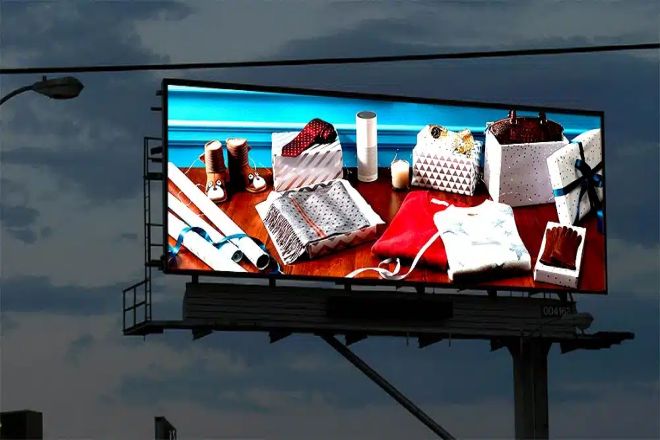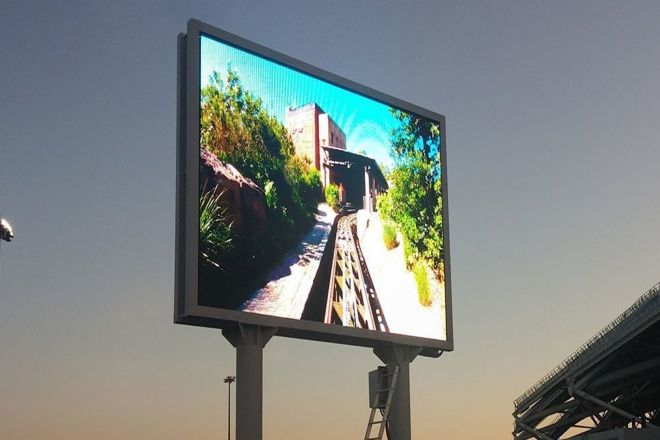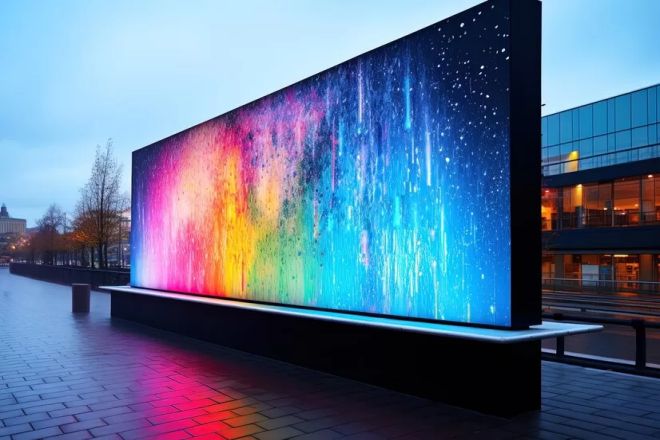Introduction

Since LED displays are usually installed in outdoor environments, they face many challenges, one of which is water intrusion. Once water enters the LED display, it may not only cause its performance to decline but may even cause serious consequences such as short circuits and fire. Therefore, it is particularly important to understand the treatment methods and preventive measures after water enters the LED display screen.
This article will introduce in detail the treatment steps after water enters the LED display screen and provide some practical preventive measures to help you better protect and maintain the LED display screen.
1. The harm caused by water entering the LED display screen
The weather is hot, and many countries and regions have begun to experience the rainy season. Ten consecutive days of heavy rain may have a certain impact on large electronic equipment such as LED displays. When water enters the LED display, it may cause the following serious hazards:
- Performance degradation:
When water enters the LED display, its performance may degrade. In mild cases, the LED light may be dimly lit, and some rows or rows of units may not light up. In severe cases, the device may be burned or even cause a short circuit in the power supply.
- Safety hazard:
When water comes into contact with the circuitry inside the display, it may cause a short circuit, which will not only damage the display but may also cause serious safety hazards such as fire.
- Impact on stability:
If all LED displays that have been flooded with water are not dealt with in time, the stability of the screen may be affected to a greater or lesser extent. During emergency treatment, the lights may continue to die after the screen is powered on.
- Device damage:
When the LED device becomes damp, the halogen in the water vapor will react electrochemically with the metal in the device. In severe cases, the chip will be short-circuited, and leakage or electrodes will fall off, resulting in blind lights and abnormal string lighting of the display device. Once these problems occur, they are often irreversible and even difficult to control.
- Difficulty in repair:
If the LED display screen is soaked in water for more than a certain period of time (such as more than 72 hours), the screen body is basically of no repair value because long-term water immersion may cause serious damage to the circuits and components inside the display screen.
Therefore, when water enters the LED display screen, corresponding measures should be taken quickly to avoid greater losses and safety hazards. At the same time, attention should also be paid to daily waterproofing and maintenance work to ensure the normal operation and service life of the LED display.
2. Preliminary treatment after water enters the LED display screen

1). Cut off the power immediately
After discovering that water has entered the LED display screen, the first and critical step is to immediately cut off the power supply. This is because water is conductive and once it comes into contact with the circuit inside the display, it may cause abnormal current flow and form a short circuit.
A short circuit will not only damage the circuits and components of the display but may also cause electric shock, posing a threat to personnel safety. Therefore, cutting off the power supply is to avoid these potential risks.
2). How to safely cut off power
To safely cut off power, follow these steps:
First, make sure you are in a safe position to avoid accidents such as electric shock or falling.
Look for and locate the display’s power switch or main power control box.
Use dry hands or tools to turn off the power switch or disconnect the power from the main power control box.
Wait for a period of time to ensure that the current inside the display disappears completely to avoid the danger caused by the residual current.
3). Quickly remove water sources
After cutting off the power supply, the water source on the display needs to be removed as soon as possible.
This is because water is corrosive to the circuits and components inside the display, and prolonged immersion can cause component damage. Therefore, removing the water source quickly is key to reducing damage.
Provide specific methods for removing water sources
To remove the water source on the display, you can do the following:
Using a dry, absorbent cloth or paper towel, gently wipe the display surface and surrounding area to absorb as much moisture as possible.
If the water source is coming from the back or sides of the display, you can try tilting or flipping the display to let the water flow out.
Use a vacuum cleaner (make sure it’s dry) to gently remove any moisture from inside the display. However, it should be noted that the vacuum cleaner may generate static electricity and cause damage to the display, so it should be used with caution.
4). Initial observations and assessment
After removing the water source, an initial observation and evaluation of the display is required. This includes checking the display for liquid residue, smoke or odors, and other abnormalities. These anomalies may be signs of water damage or electrical shorts.
However, it is important to note that even if the display surface appears to be normal, there is no guarantee that there is no internal damage.
Therefore, do not attempt to disassemble the display or perform any repair operations yourself to avoid further damage or danger. The correct approach is to contact professional maintenance personnel for further inspection and repair.
3. Professional treatment after water enters the LED display screen
1). Contact professional maintenance personnel
When an LED display screen is flooded with water, it is often difficult for ordinary users to handle it by themselves due to the damage assessment of circuits and components and the professional maintenance techniques involved. Therefore, you need to contact professional maintenance personnel for processing.
Professional maintenance personnel have rich experience and professional skills and can accurately assess the degree of damage to the display and take correct repair measures.
2). Explain why professional maintenance is required
After water enters the display screen, the internal circuits and components may be damaged to varying degrees, requiring professional testing and repair.
Professional maintenance personnel are equipped with professional testing equipment and maintenance tools and can conduct a comprehensive inspection of the display screen, determine damaged components and circuits, and take appropriate maintenance measures.
In addition, professional maintenance personnel also understand the working principles and maintenance specifications of the display screen and can ensure the safety and effectiveness of the maintenance process.
3). Provides access to professional maintenance personnel
When looking for professional maintenance personnel, you can do so through the following channels:
Brand after-sales service: If the display screen is a product of a well-known brand, you can contact the brand after-sales service center, which will usually provide professional repair services.
Professional repair company: Find a professional LED display repair company in the local area. They usually have rich repair experience and a professional technical team.
Industry recommendation: Consult with peers or people in related industries. They may recommend some reliable maintenance companies or individuals.
4). Precautions during maintenance
During the maintenance process, users need to pay attention to the following matters:
Be patient: The repair process may take a certain amount of time. Users need to be patient and not rush for success or operate on their own.
Do not operate by yourself: Since the maintenance of the display screen involves professional technology and equipment, users should not disassemble or repair the display screen by themselves to avoid causing greater damage or safety hazards.
Data protection and privacy security: If the display screen is used to display sensitive information or store important data, users need to remind maintenance personnel to pay attention to data protection and privacy security to ensure that sensitive information is not leaked or data is damaged during the maintenance process.
5). Post-repair testing and acceptance
After the repair is completed, the user needs to conduct the following tests and acceptance:
Functional test: Test whether the various functions of the display screen are normal, such as brightness, color, contrast, etc.
Stability test: Run the display for a long time and observe whether it works stably and no abnormalities occur.
Appearance inspection: Check whether the appearance of the display is intact and free of scratches, stains, etc.
6). Emphasize that users need to personally check and accept
Users need to personally participate in the post-repair testing and acceptance process to ensure that the display has returned to normal operation and meets their own needs. If you have any questions or dissatisfaction, you should promptly report it to the maintenance personnel and negotiate a solution.
4. Preventive measures for water intrusion into the LED display screen

1). Choice of installation location
When installing an LED display, choosing the correct location is the first step to prevent water intrusion. Here are some specific installation recommendations:
Waterproof location: Make sure the display is installed in an area with good waterproof performance, such as indoors or an outdoor area with waterproof facilities.
Well-ventilated: Choosing a well-ventilated location will help reduce humidity inside the display and reduce the risk of water intrusion.
Avoid low-lying areas: Avoid installing the display in low-lying areas. These areas are prone to water accumulation, increasing the possibility of water intrusion into the display.
- Make sure there are no water sources around: Before installation, make sure there are no potential water sources around the display, such as water pipes, pools, etc.
2). Regular maintenance and inspection
Regular maintenance and inspection are important measures to prevent water from entering the LED display screen. Here are some suggestions:
Clean dust: Regularly clean the dust on the surface and inside of the display to ensure heat dissipation and prevent dust accumulation from causing short circuits.
Check the circuit: Regularly check whether the circuit connection of the display screen is firm and whether there is any aging, damage, etc., and replace damaged parts in a timely manner.
Maintenance cycle: Develop a reasonable maintenance cycle based on the frequency of use of the display and environmental conditions. It is generally recommended to conduct comprehensive maintenance every six months or one year.
3). Establish an emergency response mechanism
When water or other abnormal conditions are discovered in the LED display, it is crucial to quickly activate the emergency response mechanism. Here are some suggestions:
Develop an emergency plan: Develop an emergency plan in advance for water intrusion into the display screen and clarify response measures and division of responsibilities.
Cut off the power immediately: Once you find that water has entered the display screen, cut off the power supply immediately to avoid the risk of a short circuit and electric shock.
Notify maintenance personnel: Contact professional maintenance personnel quickly to explain the situation and request emergency treatment.
Recording and reporting: Record water intrusion incidents, including time, location, cause, and other information, and report them to relevant departments.
4). The specific content and operating procedures of the emergency response mechanism
The specific emergency response mechanism should be formulated based on the actual situation but generally includes the following content and operating procedures:
Activation mechanism: After an abnormal situation is discovered, the emergency response mechanism will be activated immediately, and relevant personnel will be notified.
Preliminary treatment: Follow the above preliminary treatment methods to cut off power and remove water sources.
Contact maintenance personnel: Notify professional maintenance personnel to come and handle the problem and provide necessary support and assistance.
Maintenance and acceptance: Wait for the maintenance personnel to complete the repair, and then conduct necessary tests and acceptance to ensure that the display returns to normal operation.
Recording and summary: Record and summarize the entire emergency response process for future reference and improvement.
Conclusion
When faced with this emergency, users should remain calm, cut off the power supply quickly, and remove the water source as soon as possible. In the meantime, seeking help from a professional repairman is key to ensuring your display is repaired correctly.
In daily use, we should also strengthen maintenance and preventive measures, choose an installation location with good waterproof performance, regularly clean and inspect the display, and establish an emergency response mechanism.
Finally, if you want to know more about LED displays, please get in touch with us.
